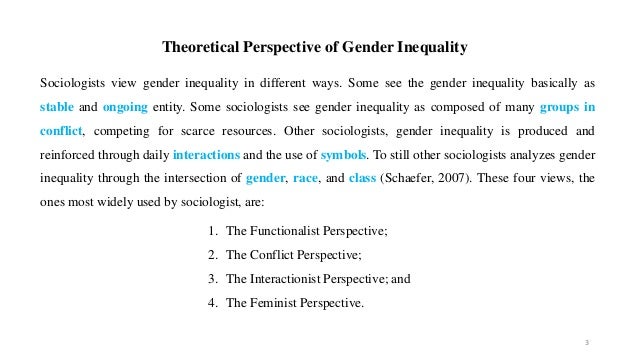
The functionalist perspective of gender inequality was most robustly articulated in the s and s, and largely developed by Talcott Parsons’ model of the nuclear family. This theory suggests that gender inequalities exist as an efficient way to create a division of labor, or as a social system in which particular segments are clearly responsible for certain, respective acts of labor Apr 17, · Functionalist Perspective of Gender Inequality. Gender inequality does not just vary between cultures, but also in their extent or degree. In the United States, for example, gender inequality often takes the form of an unequal division of homework and childcare in family roles. The functionalist approach regards society as a complex system, in the shape of which solidarity and stability have /5(22) The functionalist view of gender inequality was most firmly expressed in the ’s and ’s, and was principally developed by Parsons’ model of the nuclear family (Smith and Ingoldsby, )
Functionalist Perspective of Gender Inequality - Free Essay Example | blogger.com
The functionalist perspective of gender roles suggests that gender roles exist to maximize social efficiency.
The functionalist perspective sees society as a complex system whose parts work together to promote solidarity and stability. This approach looks at society through a macro-level orientation, which is a broad focus on the social structures that shape society as a whole, and looks at both social structure and social functions.
Functionalism addresses society as a whole in terms of the function of its constituent elements, namely: normscustoms, functionalist view on gender inequality, traditionsand institutions.
This theory suggests that gender inequalities exist as an efficient way to create a division of labor, functionalist view on gender inequality, or as a social system in which particular segments are clearly responsible for certain, respective acts of labor. The division of labor works to maximize resources and efficiency.
A structural functionalist view of gender inequality applies the division of labor to view predefined gender roles as complementary: women take care of the home while men provide for the family. Thus gender, like other functionalist view on gender inequality institutionsfunctionalist view on gender inequality, contributes to the stability of society as a whole. In sociological researchfunctional prerequisites are the basic needs food, shelter, clothing, and money that an individual requires to live above the poverty line.
Functional prerequisites may also refer to the factors that allow a society to maintain social order. According to structural functionalists, gender serves to maintain social order by providing and ensuring the stability of such functional prerequisites. This view has been criticized for reifying, rather than reflecting, gender roles. While gender roles, according to the functionalist perspective, are beneficial in that they contribute to stable social relations, many argue that gender roles are discriminatory and should not be upheld.
The feminist movement, which was on the rise at the same time that functionalism began to declinetakes the position that functionalism neglects functionalist view on gender inequality suppression of women within the family structure. html is licensed under a Creative Commons Attribution-ShareAlike 4. Skip to content The Functionalist Perspective. KEY POINTS The functionalist perspective sees society as a complex system whose parts work together to promote solidarity and stability.
This approach looks at society through a macro-level orientation and broadly focuses on the social structures that shape society as a whole. This theory suggests that gender inequalities exist as an efficient way to create a division of laboror as a social system in which a particular segment of the population is clearly responsible for certain acts of labor and another segment is clearly responsible for other labor acts.
The feminist movement takes the position that functionalism neglects the suppression of women within the family structure. Previous: Gender Differences in Social Interaction. Next: The Conflict Perspective. Share This Book Share on Twitter.
functionalist perspective on sexuality hdfs445
, time: 5:00Sociological Perspectives on Gender Stratification | Boundless Sociology

Nov 28, · The functionalist perspective assumed that men and women had different roles and positions in society, much of which was determined by inherent biological differences Apr 17, · Functionalist Perspective of Gender Inequality. Gender inequality does not just vary between cultures, but also in their extent or degree. In the United States, for example, gender inequality often takes the form of an unequal division of homework and childcare in family roles. The functionalist approach regards society as a complex system, in the shape of which solidarity and stability have /5(22) The functionalist perspective of gender inequality was most robustly articulated in the s and s, and largely developed by Talcott Parsons’ model of the nuclear family. This theory suggests that gender inequalities exist as an efficient way to create a division of labor, or as a social system in which particular segments are clearly responsible for certain, respective acts of labor
No comments:
Post a Comment